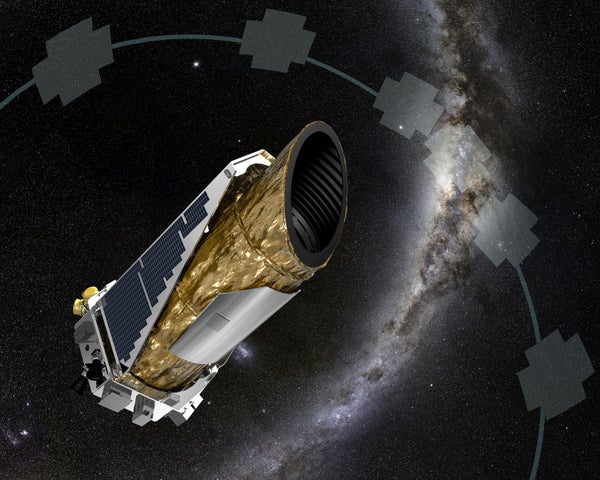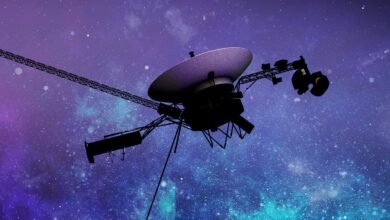
We Need Small Astronomy as Much as Big Astronomy
In an era of budget-busting mega-telescopes, we shouldn’t forget the importance of smaller telescopes, more focused missions and the unexpected surprises they reveal about the universe

Artist’s rendering of NASA’s Kepler space telescope and the observation pattern for its extended mission, called K2.
NASA/Ames/JPL-Caltech
NASA’s flagship orbiting mega-observatory, the James Webb Space Telescope, launched billions of dollars over budget and over a decade late. The space agency’s next prize, the Vera C. Rubin Observatory, will sport an 8.4-meter-diameter mirror and hopes to achieve first light in 2025 after taking nearly half a billion dollars to complete. The National Science Foundation’s Thirty Meter Telescope, currently entangled in controversy over its proposed site on Mauna Kea, is projected to cost $2.65 billion. And the international Square Kilometer Array, a radio telescope network scattered across South Africa and Western Australia, has a project price tag of over $2 billion.
It will take many years, if not decades, before the scientific community and the public will decide whether these astronomical efforts, in every sense, were worth their time and expense.
That won’t be an easy calculation. Entire careers are sunk into these mega-projects. Graduate students can rise to fully tenured professor in the time it takes for these instruments to go from concept to commissioning—assuming they survive the inevitable political machinations required for their completion.
On supporting science journalism
If you’re enjoying this article, consider supporting our award-winning journalism by subscribing. By purchasing a subscription you are helping to ensure the future of impactful stories about the discoveries and ideas shaping our world today.
In this growing era of giant observatories, multidecade observation campaigns, and continent-spanning collaborations, astronomers should instead celebrate and promote the small, the ingenious and the clever. These kinds of small-scale missions provide much more fruitful research bang for the buck, create more opportunities for original research from young scientists and generate opportunities for serendipitous discoveries.
Of course, JWST has resulted in a raft of publications. At the moment, the Space Telescope Science Institute has recorded 1,260 publications involving significant content from the space telescope, a number sure to grow. The Rubin Observatory, the Thirty Meter Telescope and the Square Kilometer Array all promise decades of fruitful scientific research ahead. Certainly, we will learn much about the cosmos with those instruments.
But nothing comes without a cost, and bigger does not always mean better. Giant projects crowd out funding for smaller ones; and once sunk-cost fallacies creep in, they can continue to pull away funding from other worthy projects. JWST’s delays didn’t just push back that instrument, but every subsequent launch after that (just ask the cosmologists who have been patiently waiting for the Nancy Grace Roman Telescope to finally get the funding needed to prepare for launch).
Astronomy has always had an abundant and lively tradition of small-scale observations making big impacts, and that tradition persists. The All-Sky Automated Survey for SuperNovae, or ASAS-SN, has discovered some of the most energetic events in the entire cosmos, costs less than $1 million a year. The Event Horizon Telescope, which released the hauntingly beautiful images of the black hole shadows, racked up a mere $60 million in funding—a relative bargain.
One of the major science goals of the Square Kilometer Array is to map out the epoch of reionization, the transformative time in the history of the universe when the first stars and galaxies flooded the cosmos with high-energy radiation. Perhaps by the time that mega-array is collecting data, smaller, more nimbler experiments, like the HERA telescope, will have already measured it—for only a few million bucks.
Even in the realm of space telescopes, where “cheap” is still half a billion dollars, many instruments have produced enormous scientific outputs for a fraction of JWST’s $10 billion price. The Kepler space telescope revolutionized our understanding of exoplanets for only $550 million. The Gaia spacecraft is remapping the Milky Way in exquisite detail for around $1 billion. Bargains, by comparison. Going back a couple decades, the WMAP satellite mapped the entire cosmic microwave background sky for $150 million.
And astronomy remains one of the only fields of science where enthusiastic amateurs can still make important discoveries, such as the sleuths who still scour the sky for new asteroids.
Even within the expensive missions, the most important research is often performed by independent research groups grabbing small slices of time. In one recent paper, a team of astronomers used Gaia data to revisit the ages of a small group of young stars. That may not seem like the most critical of astronomical research, but pinpointing those ages is crucial to understanding everything from the onset of the planet-formation process to cross-checking the age of the entire universe.
The decadal survey process, where every 10 years, active research grinds to a halt as the astronomy community decides what its priorities are, feeds this bias towards large instruments. Ironically, it’s easier to sell a small number of big-budget instruments to congress than it is to sell a multiple of small one-offs. The decadal process is a symptom of the larger disease; the community “decides” that it needs larger telescopes because we think that these are more likely to get funding.
It’s tempting as a discipline to go bigger. I understand the need for larger mirrors, more dishes, improved processing times and the like. Massive investments do indeed lead to science payoffs. But giant projects also require more, and more sustained, funding from government agencies. And they take extremely long times to come to fruition. The academics who benefit most from those arrangements are the tenured faculty, their careers safe regardless of these giant gambles. Meanwhile, young scientists can spend their entire, brief careers preparing for an instrument that won’t get built by the time they’re ready for the next step up the academic career ladder—and if it doesn’t pan out, they’ve got nothing left to stand on.
Smaller projects can be riskier. They can take more chances. A young scientist doesn’t need to hang an entire career on one. Small projects can look in the unexplored corners and hidden depths. Ironically, small telescopes and projects can find the things that the giant instruments can’t. There can be a lot of small surveys for the cost of a single giant campaign, and with many smaller projects, scientists don’t have to spend their time trying to get a small slice of the observing pie.
There will always be a need for large astronomy projects. But we should be careful that we don’t overbalance, and always keep in mind that in astronomy we have to allow ourselves to be surprised by the unexpected.
This is an opinion and analysis article, and the views expressed by the author or authors are not necessarily those of Scientific American.
Source link




